LAW514 Commercial Law Assignment: Negligence, Liability, and Damages
VerifiedAdded on 2022/11/30
|7
|1752
|141
Homework Assignment
AI Summary
This Commercial Law assignment solution addresses a problem-based question involving negligence and vicarious liability. The scenario involves a gardener subcontracted by a company to repair a rooftop garden, where a resident, Marie, is injured due to the gardener's negligence in failing to ensure proper safety measures. The solution analyzes the gardener's negligence, the company's vicarious liability for the gardener's actions, and Marie's potential damages, considering her contributory negligence for accessing the rooftop despite a warning. The analysis applies relevant legal principles and case law to determine the liability of the gardener and the company, and the extent of damages Marie can claim, including medical expenses and lost holiday money. The assignment concludes that the gardener is liable for negligence, the company is vicariously liable, and Marie's damages are reduced due to her contributory negligence, allowing her to claim for medical expenses but not for the canceled holiday.
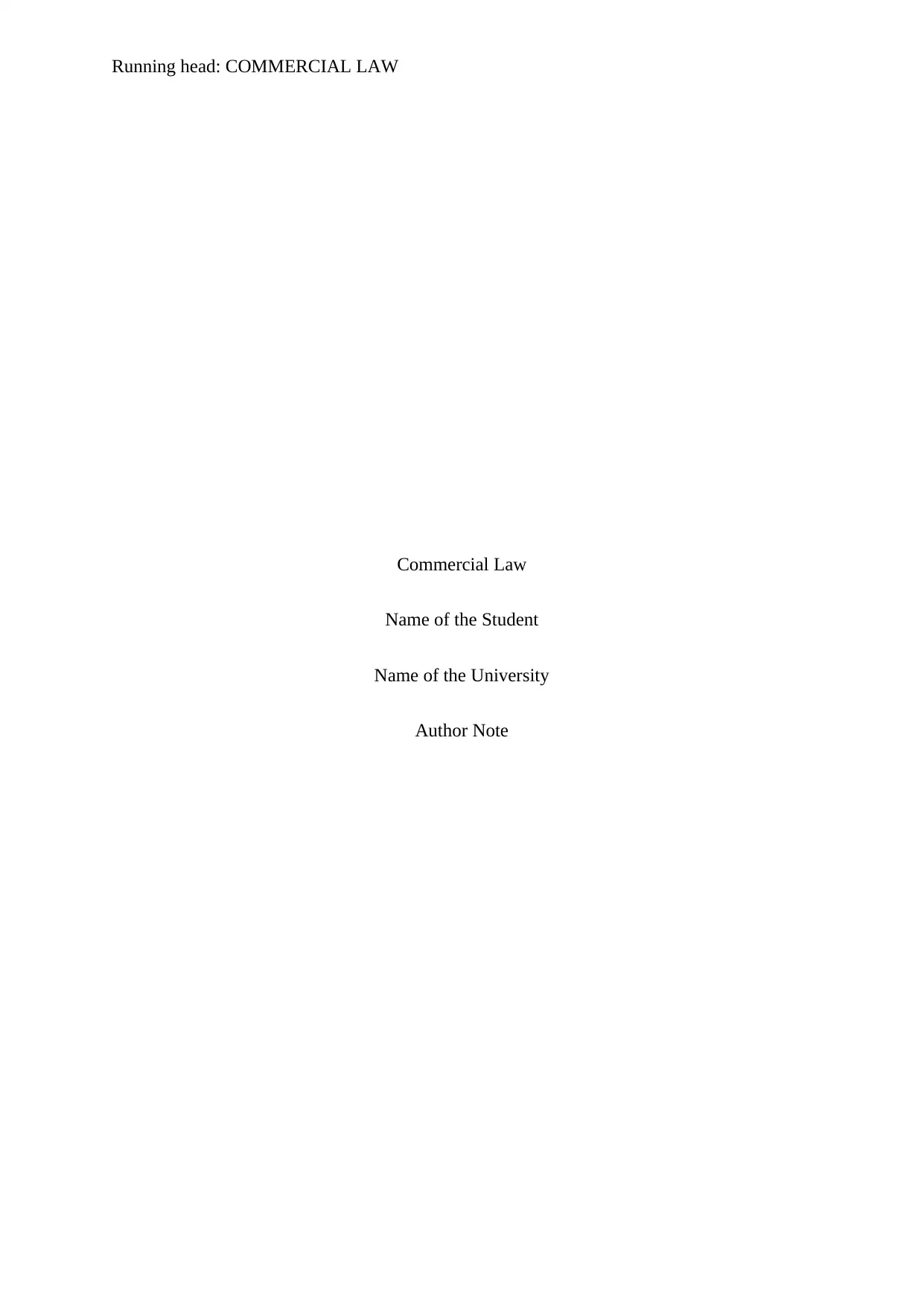
Running head: COMMERCIAL LAW
Commercial Law
Name of the Student
Name of the University
Author Note
Commercial Law
Name of the Student
Name of the University
Author Note
Paraphrase This Document
Need a fresh take? Get an instant paraphrase of this document with our AI Paraphraser
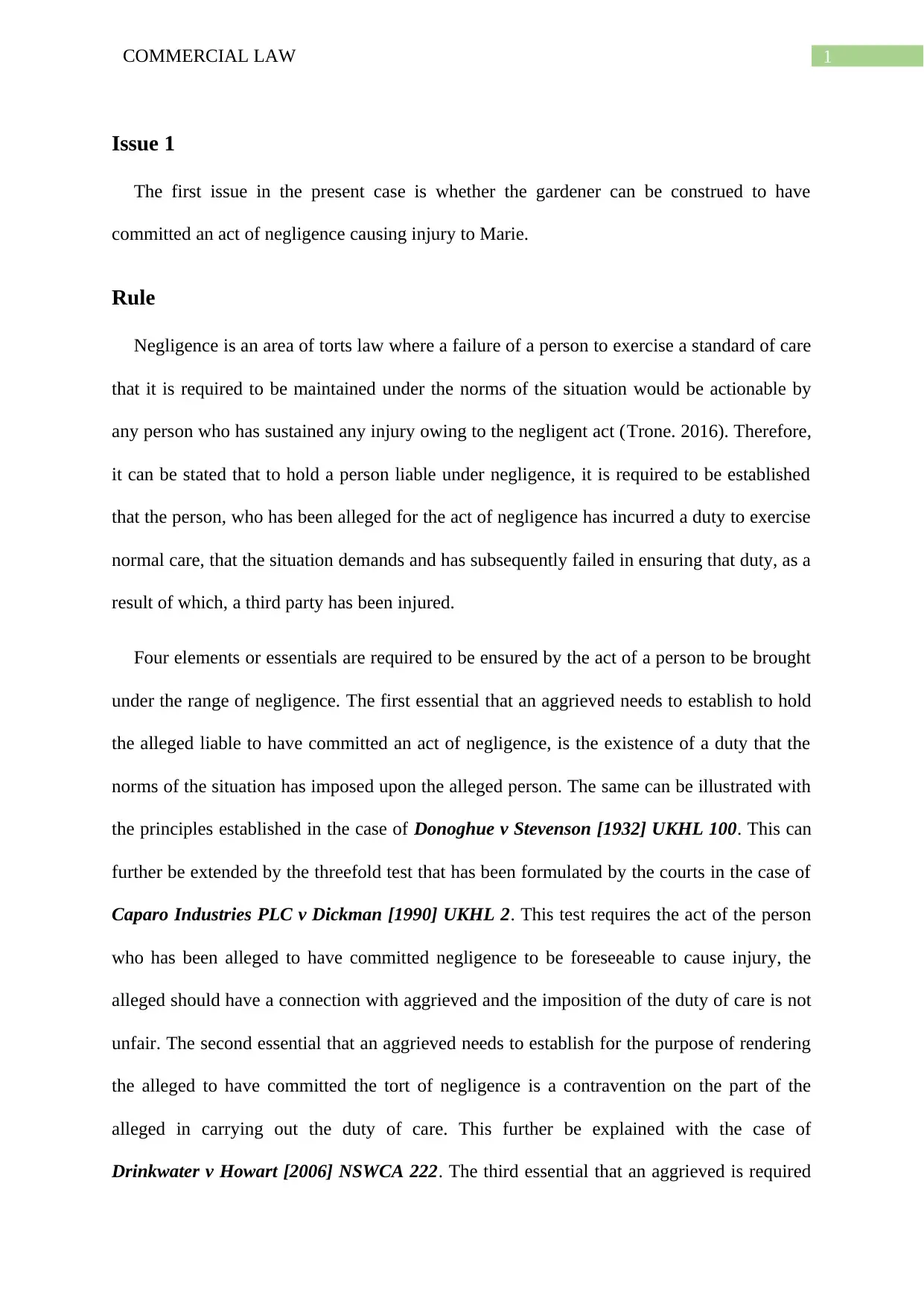
1COMMERCIAL LAW
Issue 1
The first issue in the present case is whether the gardener can be construed to have
committed an act of negligence causing injury to Marie.
Rule
Negligence is an area of torts law where a failure of a person to exercise a standard of care
that it is required to be maintained under the norms of the situation would be actionable by
any person who has sustained any injury owing to the negligent act (Trone. 2016). Therefore,
it can be stated that to hold a person liable under negligence, it is required to be established
that the person, who has been alleged for the act of negligence has incurred a duty to exercise
normal care, that the situation demands and has subsequently failed in ensuring that duty, as a
result of which, a third party has been injured.
Four elements or essentials are required to be ensured by the act of a person to be brought
under the range of negligence. The first essential that an aggrieved needs to establish to hold
the alleged liable to have committed an act of negligence, is the existence of a duty that the
norms of the situation has imposed upon the alleged person. The same can be illustrated with
the principles established in the case of Donoghue v Stevenson [1932] UKHL 100. This can
further be extended by the threefold test that has been formulated by the courts in the case of
Caparo Industries PLC v Dickman [1990] UKHL 2. This test requires the act of the person
who has been alleged to have committed negligence to be foreseeable to cause injury, the
alleged should have a connection with aggrieved and the imposition of the duty of care is not
unfair. The second essential that an aggrieved needs to establish for the purpose of rendering
the alleged to have committed the tort of negligence is a contravention on the part of the
alleged in carrying out the duty of care. This further be explained with the case of
Drinkwater v Howart [2006] NSWCA 222. The third essential that an aggrieved is required
Issue 1
The first issue in the present case is whether the gardener can be construed to have
committed an act of negligence causing injury to Marie.
Rule
Negligence is an area of torts law where a failure of a person to exercise a standard of care
that it is required to be maintained under the norms of the situation would be actionable by
any person who has sustained any injury owing to the negligent act (Trone. 2016). Therefore,
it can be stated that to hold a person liable under negligence, it is required to be established
that the person, who has been alleged for the act of negligence has incurred a duty to exercise
normal care, that the situation demands and has subsequently failed in ensuring that duty, as a
result of which, a third party has been injured.
Four elements or essentials are required to be ensured by the act of a person to be brought
under the range of negligence. The first essential that an aggrieved needs to establish to hold
the alleged liable to have committed an act of negligence, is the existence of a duty that the
norms of the situation has imposed upon the alleged person. The same can be illustrated with
the principles established in the case of Donoghue v Stevenson [1932] UKHL 100. This can
further be extended by the threefold test that has been formulated by the courts in the case of
Caparo Industries PLC v Dickman [1990] UKHL 2. This test requires the act of the person
who has been alleged to have committed negligence to be foreseeable to cause injury, the
alleged should have a connection with aggrieved and the imposition of the duty of care is not
unfair. The second essential that an aggrieved needs to establish for the purpose of rendering
the alleged to have committed the tort of negligence is a contravention on the part of the
alleged in carrying out the duty of care. This further be explained with the case of
Drinkwater v Howart [2006] NSWCA 222. The third essential that an aggrieved is required
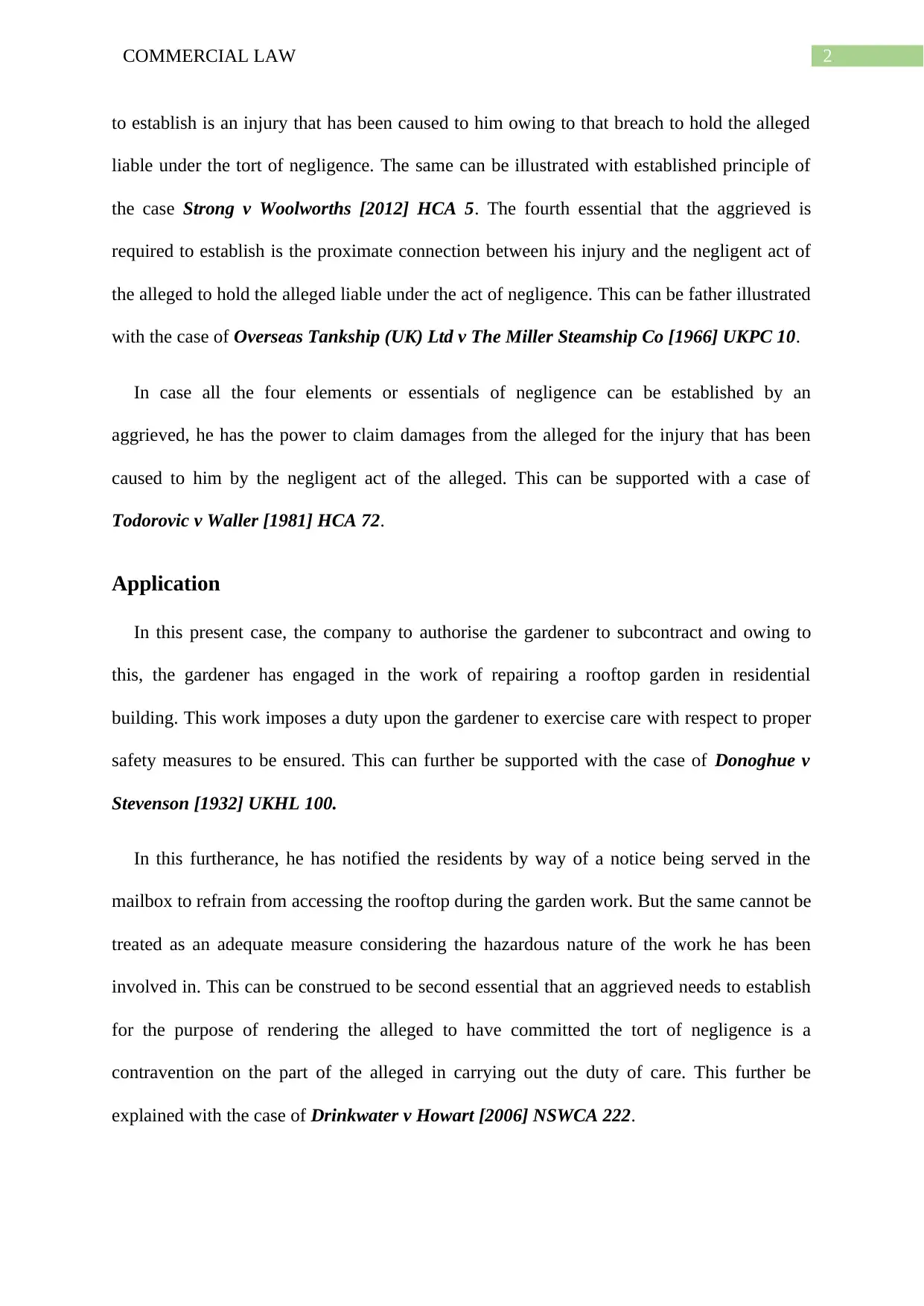
2COMMERCIAL LAW
to establish is an injury that has been caused to him owing to that breach to hold the alleged
liable under the tort of negligence. The same can be illustrated with established principle of
the case Strong v Woolworths [2012] HCA 5. The fourth essential that the aggrieved is
required to establish is the proximate connection between his injury and the negligent act of
the alleged to hold the alleged liable under the act of negligence. This can be father illustrated
with the case of Overseas Tankship (UK) Ltd v The Miller Steamship Co [1966] UKPC 10.
In case all the four elements or essentials of negligence can be established by an
aggrieved, he has the power to claim damages from the alleged for the injury that has been
caused to him by the negligent act of the alleged. This can be supported with a case of
Todorovic v Waller [1981] HCA 72.
Application
In this present case, the company to authorise the gardener to subcontract and owing to
this, the gardener has engaged in the work of repairing a rooftop garden in residential
building. This work imposes a duty upon the gardener to exercise care with respect to proper
safety measures to be ensured. This can further be supported with the case of Donoghue v
Stevenson [1932] UKHL 100.
In this furtherance, he has notified the residents by way of a notice being served in the
mailbox to refrain from accessing the rooftop during the garden work. But the same cannot be
treated as an adequate measure considering the hazardous nature of the work he has been
involved in. This can be construed to be second essential that an aggrieved needs to establish
for the purpose of rendering the alleged to have committed the tort of negligence is a
contravention on the part of the alleged in carrying out the duty of care. This further be
explained with the case of Drinkwater v Howart [2006] NSWCA 222.
to establish is an injury that has been caused to him owing to that breach to hold the alleged
liable under the tort of negligence. The same can be illustrated with established principle of
the case Strong v Woolworths [2012] HCA 5. The fourth essential that the aggrieved is
required to establish is the proximate connection between his injury and the negligent act of
the alleged to hold the alleged liable under the act of negligence. This can be father illustrated
with the case of Overseas Tankship (UK) Ltd v The Miller Steamship Co [1966] UKPC 10.
In case all the four elements or essentials of negligence can be established by an
aggrieved, he has the power to claim damages from the alleged for the injury that has been
caused to him by the negligent act of the alleged. This can be supported with a case of
Todorovic v Waller [1981] HCA 72.
Application
In this present case, the company to authorise the gardener to subcontract and owing to
this, the gardener has engaged in the work of repairing a rooftop garden in residential
building. This work imposes a duty upon the gardener to exercise care with respect to proper
safety measures to be ensured. This can further be supported with the case of Donoghue v
Stevenson [1932] UKHL 100.
In this furtherance, he has notified the residents by way of a notice being served in the
mailbox to refrain from accessing the rooftop during the garden work. But the same cannot be
treated as an adequate measure considering the hazardous nature of the work he has been
involved in. This can be construed to be second essential that an aggrieved needs to establish
for the purpose of rendering the alleged to have committed the tort of negligence is a
contravention on the part of the alleged in carrying out the duty of care. This further be
explained with the case of Drinkwater v Howart [2006] NSWCA 222.
⊘ This is a preview!⊘
Do you want full access?
Subscribe today to unlock all pages.

Trusted by 1+ million students worldwide
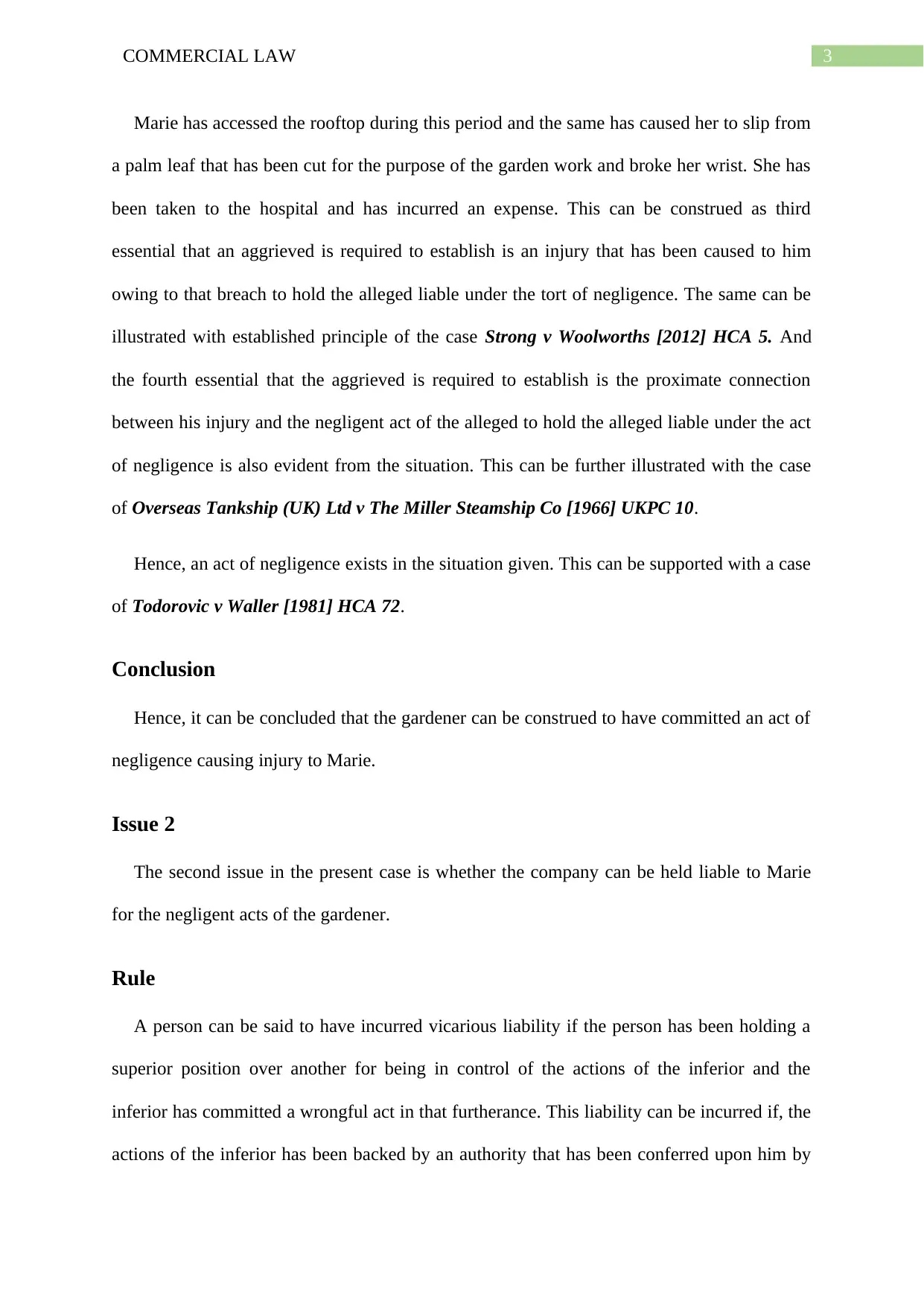
3COMMERCIAL LAW
Marie has accessed the rooftop during this period and the same has caused her to slip from
a palm leaf that has been cut for the purpose of the garden work and broke her wrist. She has
been taken to the hospital and has incurred an expense. This can be construed as third
essential that an aggrieved is required to establish is an injury that has been caused to him
owing to that breach to hold the alleged liable under the tort of negligence. The same can be
illustrated with established principle of the case Strong v Woolworths [2012] HCA 5. And
the fourth essential that the aggrieved is required to establish is the proximate connection
between his injury and the negligent act of the alleged to hold the alleged liable under the act
of negligence is also evident from the situation. This can be further illustrated with the case
of Overseas Tankship (UK) Ltd v The Miller Steamship Co [1966] UKPC 10.
Hence, an act of negligence exists in the situation given. This can be supported with a case
of Todorovic v Waller [1981] HCA 72.
Conclusion
Hence, it can be concluded that the gardener can be construed to have committed an act of
negligence causing injury to Marie.
Issue 2
The second issue in the present case is whether the company can be held liable to Marie
for the negligent acts of the gardener.
Rule
A person can be said to have incurred vicarious liability if the person has been holding a
superior position over another for being in control of the actions of the inferior and the
inferior has committed a wrongful act in that furtherance. This liability can be incurred if, the
actions of the inferior has been backed by an authority that has been conferred upon him by
Marie has accessed the rooftop during this period and the same has caused her to slip from
a palm leaf that has been cut for the purpose of the garden work and broke her wrist. She has
been taken to the hospital and has incurred an expense. This can be construed as third
essential that an aggrieved is required to establish is an injury that has been caused to him
owing to that breach to hold the alleged liable under the tort of negligence. The same can be
illustrated with established principle of the case Strong v Woolworths [2012] HCA 5. And
the fourth essential that the aggrieved is required to establish is the proximate connection
between his injury and the negligent act of the alleged to hold the alleged liable under the act
of negligence is also evident from the situation. This can be further illustrated with the case
of Overseas Tankship (UK) Ltd v The Miller Steamship Co [1966] UKPC 10.
Hence, an act of negligence exists in the situation given. This can be supported with a case
of Todorovic v Waller [1981] HCA 72.
Conclusion
Hence, it can be concluded that the gardener can be construed to have committed an act of
negligence causing injury to Marie.
Issue 2
The second issue in the present case is whether the company can be held liable to Marie
for the negligent acts of the gardener.
Rule
A person can be said to have incurred vicarious liability if the person has been holding a
superior position over another for being in control of the actions of the inferior and the
inferior has committed a wrongful act in that furtherance. This liability can be incurred if, the
actions of the inferior has been backed by an authority that has been conferred upon him by
Paraphrase This Document
Need a fresh take? Get an instant paraphrase of this document with our AI Paraphraser
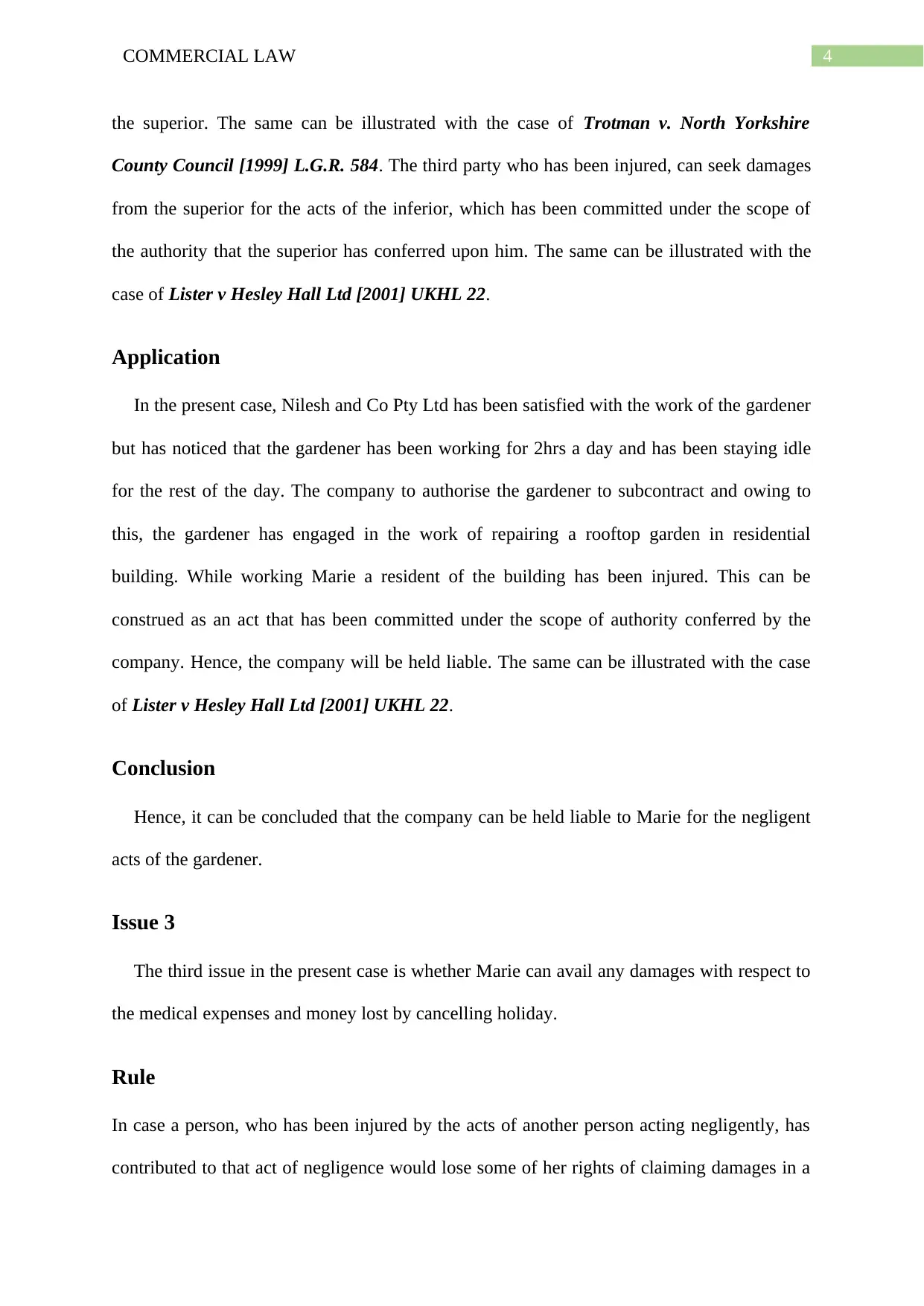
4COMMERCIAL LAW
the superior. The same can be illustrated with the case of Trotman v. North Yorkshire
County Council [1999] L.G.R. 584. The third party who has been injured, can seek damages
from the superior for the acts of the inferior, which has been committed under the scope of
the authority that the superior has conferred upon him. The same can be illustrated with the
case of Lister v Hesley Hall Ltd [2001] UKHL 22.
Application
In the present case, Nilesh and Co Pty Ltd has been satisfied with the work of the gardener
but has noticed that the gardener has been working for 2hrs a day and has been staying idle
for the rest of the day. The company to authorise the gardener to subcontract and owing to
this, the gardener has engaged in the work of repairing a rooftop garden in residential
building. While working Marie a resident of the building has been injured. This can be
construed as an act that has been committed under the scope of authority conferred by the
company. Hence, the company will be held liable. The same can be illustrated with the case
of Lister v Hesley Hall Ltd [2001] UKHL 22.
Conclusion
Hence, it can be concluded that the company can be held liable to Marie for the negligent
acts of the gardener.
Issue 3
The third issue in the present case is whether Marie can avail any damages with respect to
the medical expenses and money lost by cancelling holiday.
Rule
In case a person, who has been injured by the acts of another person acting negligently, has
contributed to that act of negligence would lose some of her rights of claiming damages in a
the superior. The same can be illustrated with the case of Trotman v. North Yorkshire
County Council [1999] L.G.R. 584. The third party who has been injured, can seek damages
from the superior for the acts of the inferior, which has been committed under the scope of
the authority that the superior has conferred upon him. The same can be illustrated with the
case of Lister v Hesley Hall Ltd [2001] UKHL 22.
Application
In the present case, Nilesh and Co Pty Ltd has been satisfied with the work of the gardener
but has noticed that the gardener has been working for 2hrs a day and has been staying idle
for the rest of the day. The company to authorise the gardener to subcontract and owing to
this, the gardener has engaged in the work of repairing a rooftop garden in residential
building. While working Marie a resident of the building has been injured. This can be
construed as an act that has been committed under the scope of authority conferred by the
company. Hence, the company will be held liable. The same can be illustrated with the case
of Lister v Hesley Hall Ltd [2001] UKHL 22.
Conclusion
Hence, it can be concluded that the company can be held liable to Marie for the negligent
acts of the gardener.
Issue 3
The third issue in the present case is whether Marie can avail any damages with respect to
the medical expenses and money lost by cancelling holiday.
Rule
In case a person, who has been injured by the acts of another person acting negligently, has
contributed to that act of negligence would lose some of her rights of claiming damages in a
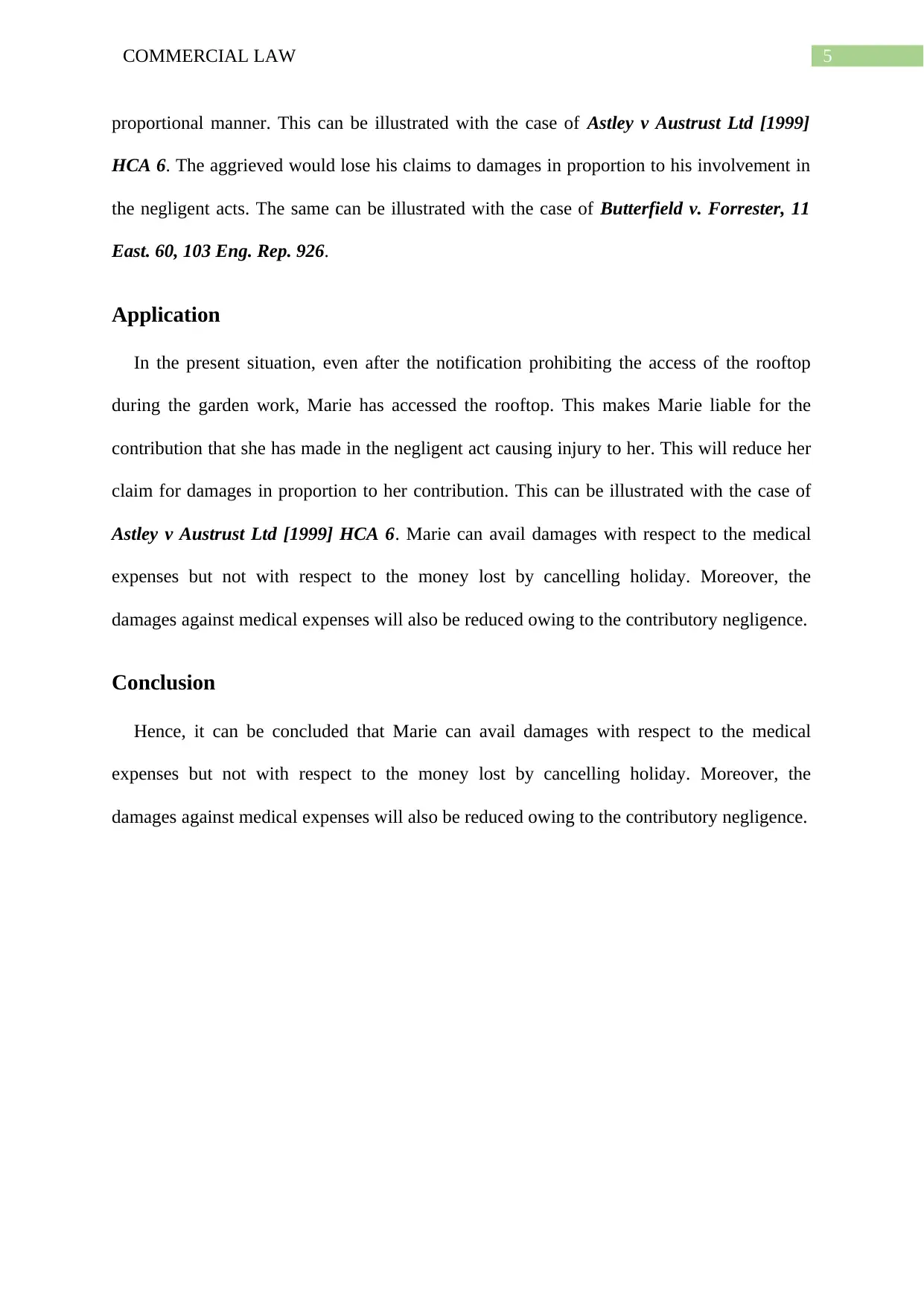
5COMMERCIAL LAW
proportional manner. This can be illustrated with the case of Astley v Austrust Ltd [1999]
HCA 6. The aggrieved would lose his claims to damages in proportion to his involvement in
the negligent acts. The same can be illustrated with the case of Butterfield v. Forrester, 11
East. 60, 103 Eng. Rep. 926.
Application
In the present situation, even after the notification prohibiting the access of the rooftop
during the garden work, Marie has accessed the rooftop. This makes Marie liable for the
contribution that she has made in the negligent act causing injury to her. This will reduce her
claim for damages in proportion to her contribution. This can be illustrated with the case of
Astley v Austrust Ltd [1999] HCA 6. Marie can avail damages with respect to the medical
expenses but not with respect to the money lost by cancelling holiday. Moreover, the
damages against medical expenses will also be reduced owing to the contributory negligence.
Conclusion
Hence, it can be concluded that Marie can avail damages with respect to the medical
expenses but not with respect to the money lost by cancelling holiday. Moreover, the
damages against medical expenses will also be reduced owing to the contributory negligence.
proportional manner. This can be illustrated with the case of Astley v Austrust Ltd [1999]
HCA 6. The aggrieved would lose his claims to damages in proportion to his involvement in
the negligent acts. The same can be illustrated with the case of Butterfield v. Forrester, 11
East. 60, 103 Eng. Rep. 926.
Application
In the present situation, even after the notification prohibiting the access of the rooftop
during the garden work, Marie has accessed the rooftop. This makes Marie liable for the
contribution that she has made in the negligent act causing injury to her. This will reduce her
claim for damages in proportion to her contribution. This can be illustrated with the case of
Astley v Austrust Ltd [1999] HCA 6. Marie can avail damages with respect to the medical
expenses but not with respect to the money lost by cancelling holiday. Moreover, the
damages against medical expenses will also be reduced owing to the contributory negligence.
Conclusion
Hence, it can be concluded that Marie can avail damages with respect to the medical
expenses but not with respect to the money lost by cancelling holiday. Moreover, the
damages against medical expenses will also be reduced owing to the contributory negligence.
⊘ This is a preview!⊘
Do you want full access?
Subscribe today to unlock all pages.

Trusted by 1+ million students worldwide
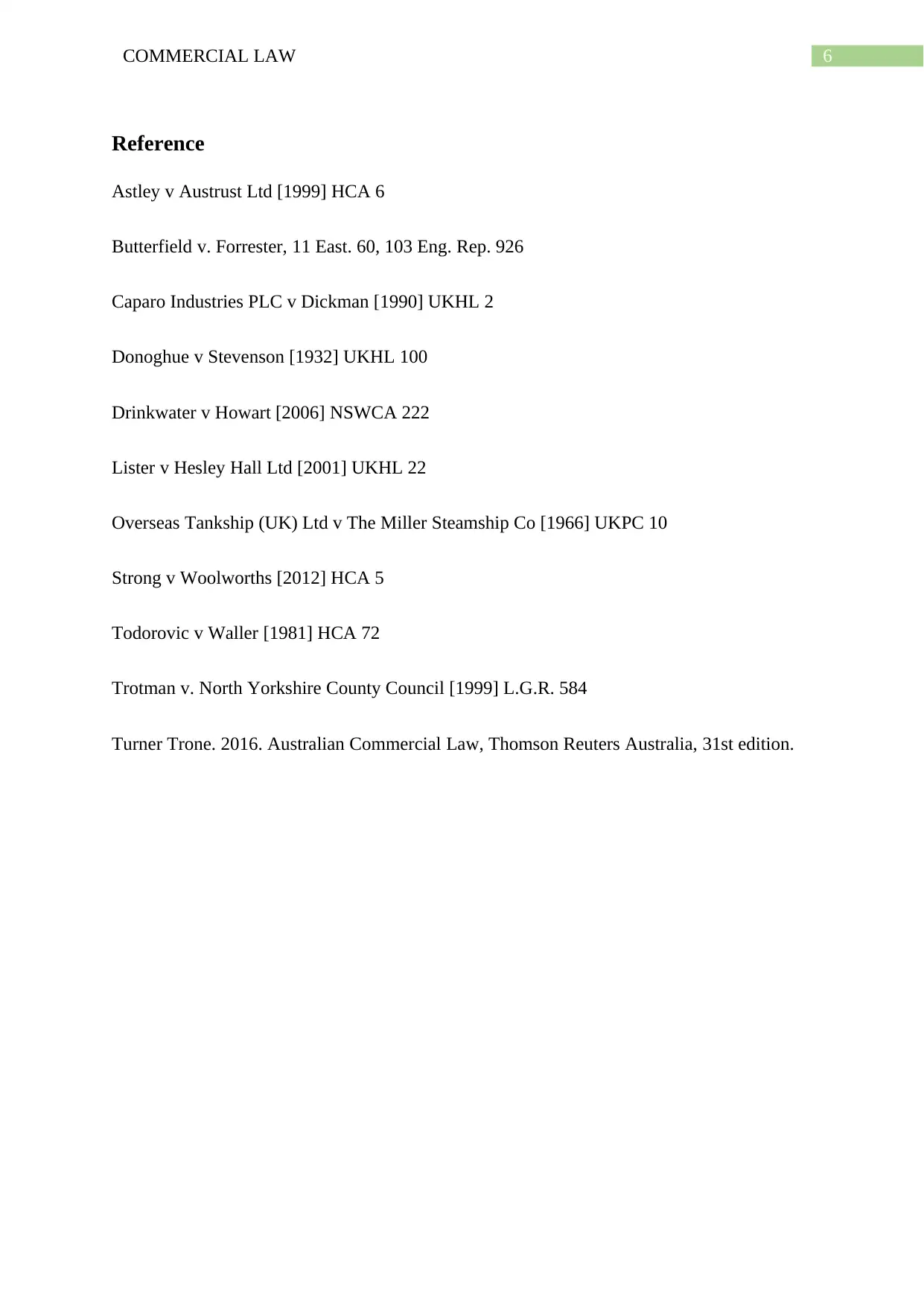
6COMMERCIAL LAW
Reference
Astley v Austrust Ltd [1999] HCA 6
Butterfield v. Forrester, 11 East. 60, 103 Eng. Rep. 926
Caparo Industries PLC v Dickman [1990] UKHL 2
Donoghue v Stevenson [1932] UKHL 100
Drinkwater v Howart [2006] NSWCA 222
Lister v Hesley Hall Ltd [2001] UKHL 22
Overseas Tankship (UK) Ltd v The Miller Steamship Co [1966] UKPC 10
Strong v Woolworths [2012] HCA 5
Todorovic v Waller [1981] HCA 72
Trotman v. North Yorkshire County Council [1999] L.G.R. 584
Turner Trone. 2016. Australian Commercial Law, Thomson Reuters Australia, 31st edition.
Reference
Astley v Austrust Ltd [1999] HCA 6
Butterfield v. Forrester, 11 East. 60, 103 Eng. Rep. 926
Caparo Industries PLC v Dickman [1990] UKHL 2
Donoghue v Stevenson [1932] UKHL 100
Drinkwater v Howart [2006] NSWCA 222
Lister v Hesley Hall Ltd [2001] UKHL 22
Overseas Tankship (UK) Ltd v The Miller Steamship Co [1966] UKPC 10
Strong v Woolworths [2012] HCA 5
Todorovic v Waller [1981] HCA 72
Trotman v. North Yorkshire County Council [1999] L.G.R. 584
Turner Trone. 2016. Australian Commercial Law, Thomson Reuters Australia, 31st edition.
1 out of 7
Related Documents
Your All-in-One AI-Powered Toolkit for Academic Success.
+13062052269
info@desklib.com
Available 24*7 on WhatsApp / Email
![[object Object]](/_next/static/media/star-bottom.7253800d.svg)
Unlock your academic potential
Copyright © 2020–2025 A2Z Services. All Rights Reserved. Developed and managed by ZUCOL.





